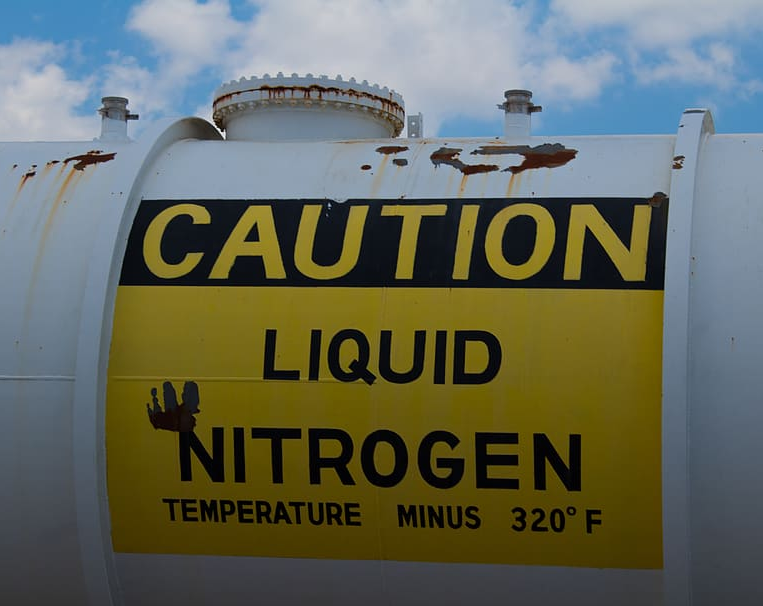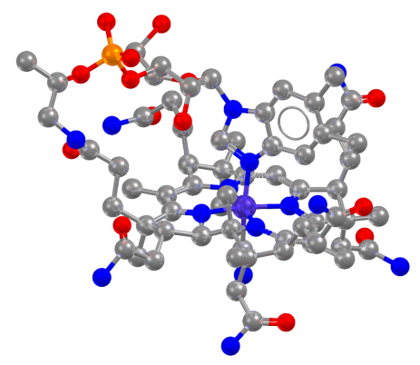Nitrogen
Nitrogen:

Image showing a tank of liquid nitrogen
Facts about Nitrogen:
- Nitrogen: Under normal conditions Nitrogen exists as dinitrogen and is a colourless, tasteless and odourless gas with the formula N2
- Fun fact about Nitrogen: Nitrogen has a boiling point of 77 K (or −196 °C, −320 °F) and liquid nitrogen is a cheap, readily available way of lowering temperatures. It can be used as a computer coolant and can be used in medicine to remove unwanted skin, warts and pre-cancerous cells. Scientists use it to study the effect of very cold temperatures on materials in a discipline known as cryogenics. Some chefs even use liquid nitrogen to make ice-cream as it quickly freezes the ice-cream mixture so it speeds up the ice-cream making process.
- Chemical symbol: N
- Atomic number: 7
A crystal structure containing Nitrogen:

Image showing the structure of Vitamin B12 determined by Dorothy Hodgkin. Cobalt in purple is surrounded by four blue nitrogen atoms. The hydrogen atoms have not been determined in this structure.
Facts about this structure:
- Formula: C63 H88 Co N14 O14 P, 22(H2O)
- Structure name: Vitamin B12 hydrate
- Fun fact about the structure: Vitamin B12 is the largest and most structurally complex vitamin and is involved in the metabolism of every cell of the human body. This structure was determined by Dorothy Hodgkin who turned a childhood interest in crystals into the ground-breaking use of X-ray crystallography to “see” the molecules of penicillin, vitamin B12 and insulin. She went on to become the third woman to win the Nobel Prize for Chemistry in 1964.
- CSD refcode: VITAMB (What’s this?)
- Associated publication: C.Brink-Shoemaker, D.W.J.Cruickshank, D.C.Hodgkin, M.J.Kamper, D.Pilling, Proceedings of the Royal Society London,Series A, 1964, 278, 1, DOI: 10.1098/rspa.1964.0042
More about Nitrogen:
Scottish physician Daniel Rutherford is usually credited with the discovery of Nitrogen in 1772. Jean-Antoine-Claude Chaptal went on to suggest the name Nitrogen in 1790 when it was found that it was present in nitric acid and nitrates. Nitrogen is the most abundant element and we need it to live, about 3.2% of our body mass is nitrogen and it is present in many of the foods we eat including meat, fish and milk. Nitrogen also helps plants to grow strong and grow new leaves and if you see plants turning yellow it shows a lack of nitrogen. Although you may think the air we breathe is just oxygen it is actually 78% nitrogen! Saturn’s moon Titan beats that with an astonishing 98% nitrogen! The element can be found in lots of pharmaceutical drugs as well as fertilizers and explosives and is one of the key components in Laughing Gas (also known as Nitrous Oxide). Nitrogen is also present in many poisons including toxic cyanide containing compounds such as hydrogen cyanide. Interestingly, another nitrogen containing compound Hydroxocobalamin (vitamin B12a) appears to be useful as an antidote to hydrogen cyanide and is generally used as the first-line of defense for cyanide poisoning.
Learn More About the International Year of the Periodic Table (IYPT) in Crystals Project:
This project (#IYPTCrystals) is part of the International Year of the Periodic Table celebration (#IYPT2019), read more about the project here.
You can follow us on social media; search for #IYPTCrystals or follow The CCDC on X @ccdc_cambridge on Facebook ccdc.cambridge, on Instagram ccdc_cambridge or on YouTube CCDCCambridge.
Understand some of the terms and concepts used with our Frequently Asked Questions page here.
A 3D visualization showing Nitrogen in real crystal structures: